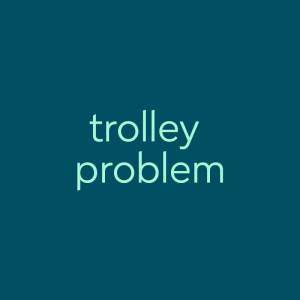Pop Culture dictionary
trolley problem
[ trol-ee prob-luhm ]
What is the trolley problem?
The trolley problem is a thought experiment in ethics that poses a hypothetical scenario in which a person is required to make a choice between two negative outcomes.
There are many variations of the trolley problem, but the classic scenario is typically something like this: a trolley is headed toward five people stuck on the track. The driver of the trolley (or an onlooker) can divert the trolley to another track. However, one person is stuck on that track. The problem asks whether the person with the ability to act should divert the trolley to the other track (saving five people but actively causing the death of one person) or do nothing (allowing the death of five people).
The trolley problem is typically understood as being intended to pose the more general philosophical question of whether it’s ethical to perform an action that harms someone in order to prevent a greater number of people from being harmed.
The term trolley problem is also sometimes used more generally to refer to any situation requiring a difficult ethical or moral decision.
The concept of the trolley problem was introduced in the 1960s, but awareness of the term and concept became more widespread in the 2010s when it started to be used in a meme featuring a rendering of the hypothetical scenario it presents. The meme often pokes fun at the trolley problem by presenting ridiculous scenarios involving trolleys.
Where does trolley problem come from?

The creation of the trolley problem thought experiment is credited to philosopher Philippa Foot, who introduced it in her 1967 article “The Problem of Abortion and the Doctrine of the Double Effect.” Foot’s scenario used the word tram (not trolley) and involved a tram driver who could choose to save five people by swerving into one.
Another philosopher, Judith Thomson, expanded the thought experiment and created two now-classic versions of it that add additional moral complications: one in which the driver is substituted with an onlooker, and another in which an onlooker can choose to push a man in the path of the trolley in order to stop it.
Over time, many different variations of the trolley problem have been created based on what philosophical or ethical question someone wants to address. For example, one version of the trolley problem asks a person if they would be willing to direct the trolley away from a single friend or loved one toward multiple strangers.
The trolley problem has since become so widely known that the term is sometimes used to refer to moral dilemmas or applied to existing situations, such as the idea that AI-guided self-driving vehicles will inevitably be faced with real-life versions of the trolley problem.
Examples of trolley problem
Who uses trolley problem?
The trolley problem is perhaps best known for its use in a meme, but it’s a popular thought experiment in the context of ethics and philosophy. The term is sometimes used in reference to no-win scenarios.
A trolley is taking a group of philosophers to a trolley-problem convention. If they arrive there safely they will generate hundreds, if not thousands, of new trolley-problem scenarios. Before you is a lever,
— Jesse Singal (@jessesingal) June 26, 2018
Living in America in 2020 is like trying to teach the trolley problem to a class of people whose only concern is whether or not the trolley got hurt.
— Jennifer Wright (@JenAshleyWright) May 11, 2020
Today at dinner, the boys discussed the consequences of Asimov’s laws of robotics in the context of the trolley problem. We may have hit peak nerd.
— Duane Watson (@duane_g_watson) November 23, 2021
Note
This is not meant to be a formal definition of trolley problem like most terms we define on Dictionary.com, but is rather an informal word summary that hopefully touches upon the key aspects of the meaning and usage of trolley problem that will help our users expand their word mastery.